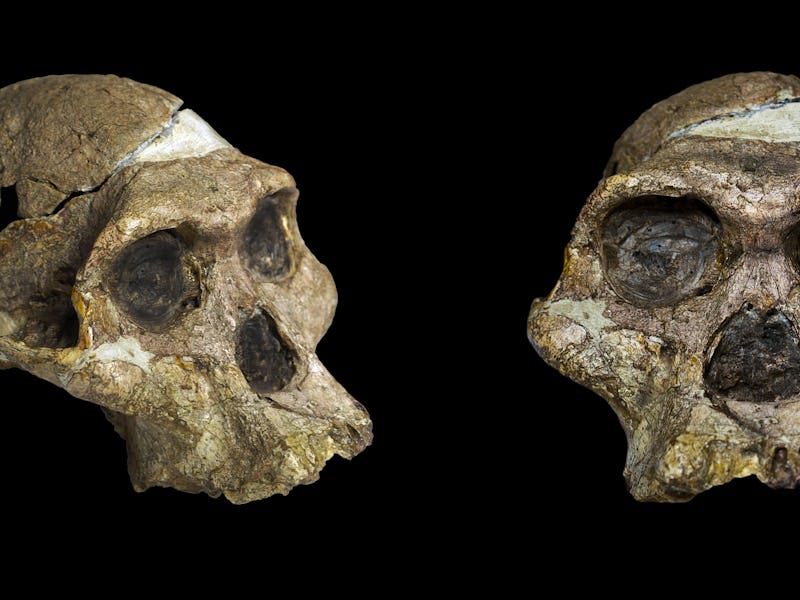Ancient Human Genomes Reveal Complicated Split Into Europeans and Asians
Isolated human populations could never really stay apart.

Research on the genes of ancient humans is speedily growing in scope, revealing insights into what it means to be a living human thousands of years after Homo sapiens became the only living hominins. We may have outlived our hominin relatives, like the Neanderthals and Denisovans, but that’s not to say our evolution became vastly simplified once they were out of the picture. As our ancestors spread throughout the planet and grew more isolated from each other, different populations came to have distinct sets of genes, leading to the differences we see in people around the globe today.
But the story is far from straightforward. A new analysis of different ancient DNA studies published Thursday in Trends in Genetics reveals that the genes of ancient humans who lived in Eurasia between 45,000 to 7,500 years ago are more complicated than previously realized. Not only does the analysis, carried out by researchers from the Chinese Academy of Sciences, show that Europeans and Asians were far from distinct; it also shows that there were at least two periods of time where there was major inbreeding between Neanderthals and humans: one event 50,000 to 60,000 years ago, and another more than 37,000 years ago.
“With large present-day genomic datasets and increased international collaboration to handle the many newly sequenced ancient datasets, there is huge potential to understand the biology of human prehistory in a way that has never been accessible before,” co-author and geneticist Qiaomei Fu, Ph.D., explained in a statement released Thursday.
Schematic mapping of ancient population dynamics in Eurasia.
Fu and co-author Melinda Yang, Ph.D., reached their conclusions by summarizing previous research on 20 ancient humans belonging to the Eurasian family tree. Comparing the DNA sequences of these individuals revealed that, between 15,000 to 34,000 years ago, the humans living in Eurasia had genetic profiles similar to either Europeans or Asians — that is, they had become distinct. This hinted to Fu and Yang that a genetic separation between Asians and Europeans likely happened well before that, around 40,000 years ago.
But in younger Eurasian fossils, those from around 7,500 to 14,000 years ago, the genetic gap appeared to have shrunk again, showing humans with genetic similarities to both Asians and Europeans. This suggests that, during this time, the once-distinct Asian and European populations had interacted once again, thereby complicating the genetic history of these groups.
Further adding to the genetic confusion were the Neanderthals, who ancient humans insisted on hooking up with. While today approximately two percent of modern humans from non-African populations still have Neanderthal DNA in their genomes, the researchers found that Neanderthal ancestry as a whole began to decline in Europe only around 14,000 to 37,000 years ago. That decline is reflected in populations today. Now, East Asians show more Neanderthal ancestry than Europeans do, with approximately 2.3 to 2.6 percent of the population containing Neanderthal DNA, compared to the 1.8 to 2.4 percent of Europeans who have the same. Some European populations have also been found to have genomes belonging to another ancestral group that split away from non-African populations early on, known as the “Basal Europeans.”
One ancient human, in particular, illustrates how dynamic populations were Eurasian thousands of years ago, and adds some light to how the split into current genetic groups happened. The Ust’-Ishim man is the name given to the 45,000-year-old remains found of a being who once lived in western Siberia. He lived when Neanderthals were still roaming around Eurasia, and like modern humans, he was a human who shared Neanderthal DNA. But his amount of Neanderthal genetics was much larger: His Neanderthal genome is 1.8 to 4.2 times longer than those found in present populations.
The femur of the Ust'Ishim man
Wang and Fu write that they next hope to extend their analysis to other ancient human populations, including people who lived in Oceania, Africa, and the Americas. These regions have been neglected in studying human prehistory, despite the fact that the ancient DNA found here will help resolve questions about human migration and evolution as well. Ancient DNA, they write, will help unravel history, and there are more “correlations between biology and culture to be explored.”